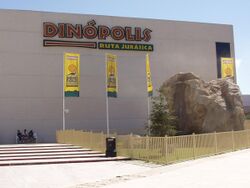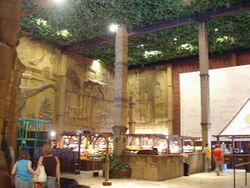Biology:Dinópolis
 Dinópolis Teruel | |
| Established | 2001 |
|---|---|
| Location | Avda. Sagunto, Teruel, Spain |
| Type | Paleontology |
| Website | [1] |
Dinópolis, located in Teruel, Spain ,[1] is one of the largest museums of paleontology in the world.[citation needed] It also includes some attractions, restaurants and shows. The museum comprises three main exhibition halls and a research laboratory.
History
In 1998, the provincial government of Aragón established a foundation with the aim of creating exhibition facilities for the growing collection of fossils found in Teruel, at the same time stimulating tourism and hereby funding future research.[citation needed] The first building was opened in June 2001, at Dinópolis Teruel.
Exhibition halls
Dinópolis has the following exhibition halls:[citation needed]
- Aquatic Life Hall
- Dinosaur Hall
- Mammal Hall
- Hall of Meteorites
Territorio Dinópolis
Dinópolis Teruel is part of a chain of eight such natural history museums and parks named Territorio Dinópolis, the seven others being Inhóspitak at Peñarroya de Tastavins, founded in 2003, Legendark at Galve (2003), Región Ambarina: at Rubielos de Mora (2004), Bosque Pétreo (2005) at Castellote, Mar Nummus, at Albarracín (2008), Titania at Riodeva (2012) and Valcaria at Ariño (2015).[citation needed]
Research activities
Dinópolis has an active research team, called Fundación Conjunto Paleontológico de Teruel-Dinópolis or just Fundación Dinópolis.[citation needed] One of the achievements of this team has been the description of Turiasaurus riodevensis by Royo-Torres, Cobos & Alcala, 2006.[citation needed]
In popular culture
- An episode of Historia de España is set in Dinópolis, and also in some outcrops in Teruel.[citation needed]
References
- ↑ "Territorio Dinópolis". Spain: TripAdvisor. http://www.tripadvisor.es/Attraction_Review-g580279-d2151590-Reviews-Territorio_Dinopolis-Teruel_Province_of_Teruel_Aragon.html. Retrieved 29 September 2014.
External links
[ ⚑ ] 40°19′57″N 1°04′52″W / 40.3325°N 1.08111°W
 |


